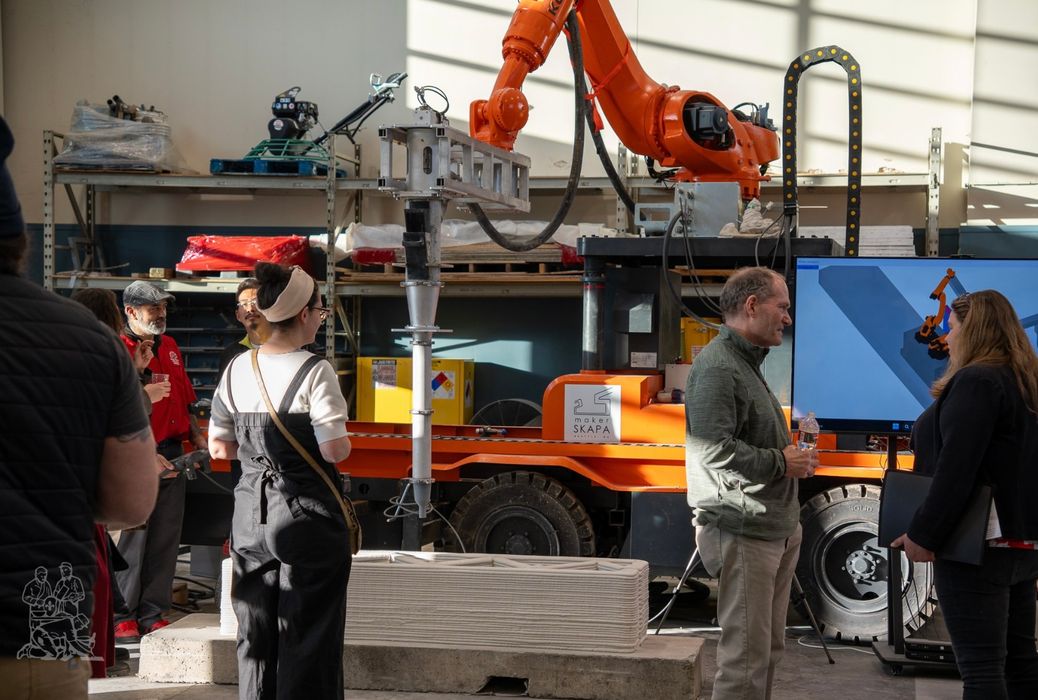
Charles R. Goulding and Preeti Sulibhavi discover how SKAPA’s Innovation Tour showcased the potential of 3D printing technology to create customized and sustainable landscape features.
In an exciting development for the landscape architecture industry, SKAPA, PLLC, a woman-owned studio, hosted an innovative educational event called the “Innovation Tour.” Throughout April 2024, this tour focused on the latest advancements in 3D concrete printing, culminating in a main event on April 30 that featured notable attendees, including Washington’s Governor Jay Inslee. The event showcased the integration of 3D printing technology into landscape architecture and construction, highlighting its potential to revolutionize the industry.

Advancing Technology: The RIC-M1 Pro
At the center of the Innovation Tour was the RIC-M1 Pro, an advanced robotic arm 3D printing system developed by RIC Technology. This technology represents a significant leap forward in construction methods, offering enhanced design freedom and sustainability. Governor Inslee expressed keen interest in the technology’s potential to reduce the greenhouse gas footprint of the construction industry, aligning with broader environmental goals.
Collaborative Efforts The success of the Innovation Tour was bolstered by strategic partnerships with key industry players, including Cement Masons and Plasterers’ Local 528 and Alquist 3D. Cement Masons and Plasterers’ Local 528, a union based in the Pacific Northwest, specializes in training and representing skilled professionals in concrete and plaster work. Alquist 3D is known for its pioneering use of 33D is known for its pioneering use of 3D printing in construction, making them a vital collaborator in this initiative.

The Role of 3D Printing in Landscape Architecture
Lindsey Heller, founder of SKAPA, emphasized the transformative potential of 3D printing in landscape architecture. She highlighted how the technology allows for the creation of customized site features such as stormwater management systems, site walls, and recreational amenities like pools and spas. “With 3D printing’s freedom of design and use of new and greener materials, I see this new technology as a path to more integrated custom site features,” Heller explained.
Residential Applications and Innovations
The integration of 3D printing in residential landscaping is a burgeoning area of interest. For instance, we have explored how 3D printing can be utilized in creating she sheds, men’s sheds, and detached accessory dwelling units (DADUs), offering homeowners personalized and efficient solutions for backyard retreats and additional living spaces.
She Sheds and Men’s Sheds
3D printing enables the creation of highly customized she sheds and men’s sheds, turning these backyard sanctuaries into unique, functional spaces. Whether for hobbies, relaxation, or work, the precision and flexibility of 3D printing allow for tailored designs that reflect individual tastes and needs. We have discussed how this technology can bring dream spaces to life, making them accessible and personalized.
DADUs: A Solution for Affordable Housing
The use of 3D printing in constructing DADUs presents a practical solution to the affordable housing crisis. This technology can streamline the construction process, making it faster and more cost-effective while reducing material waste. This approach not only provides affordable housing options but also allows for innovative architectural designs that fit seamlessly into existing landscapes.
Enhancing Outdoor Spaces with 3D Printing
The potential of 3D printing in creating residential plant appliances and lighting fixtures is becoming apparent. Customized planters, garden tools, and light fixtures can be produced on demand, providing homeowners with unique and functional elements that enhance their outdoor spaces. This ability to create bespoke items is particularly valuable for landscape architects seeking to incorporate specific design elements into their projects.
The Research & Development Tax Credit
The now permanent Research and Development (R&D) Tax Credit is available for companies developing new or improved products, processes and/or software.
3D printing can help boost a company’s R&D Tax Credits. Wages for technical employees creating, testing and revising 3D printed prototypes can be included as a percentage of eligible time spent for the R&D Tax Credit. Similarly, when used as a method of improving a process, time spent integrating 3D printing hardware and software counts as an eligible activity. Lastly, when used for modeling and preproduction, the costs of filaments consumed during the development process may also be recovered.
Whether it is used for creating and testing prototypes or for final production, 3D printing is a great indicator that R&D Credit-eligible activities are taking place. Companies implementing this technology at any point should consider taking advantage of R&D Tax Credits.
Conclusion
SKAPA’s Innovation Tour underscores the transformative potential of 3D printing technology in landscape architecture. By showcasing the capabilities of the RIC-M1 Pro and fostering strategic partnerships, SKAPA has demonstrated how 3D printing can be seamlessly integrated into existing construction practices. Governor Jay Inslee’s support highlights the technology’s environmental benefits, aligning with broader sustainability goals.
